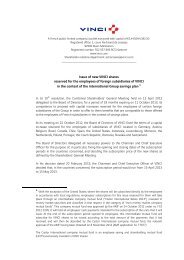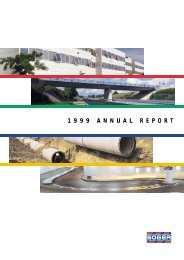VINCI - 2005 annual report
VINCI - 2005 annual report
VINCI - 2005 annual report
Create successful ePaper yourself
Turn your PDF publications into a flip-book with our unique Google optimized e-Paper software.
Joint venture partnerships created for specific construction projects<br />
and that manage revenue of over €45 million (on a 100% basis) are<br />
consolidated proportionately.<br />
CONSOLIDATED FINANCIAL STATEMENTS<br />
31 December <strong>2005</strong> 31 December 2004<br />
Total France Foreign Total France Foreign<br />
Full consolidation 1,364 928 436 1,347 913 434<br />
Proportionate consolidation 302 146 156 291 139 152<br />
Equity method 38 16 22 38 18 20<br />
1,704 1,090 614 1,676 1,070 606<br />
Intragroup transactions<br />
Reciprocal operations and transactions relating to assets and liabilities,<br />
income and expenses between consolidated or equity-accounted companies<br />
are, in general, eliminated in the consolidated financial statements. This is<br />
done:<br />
– for the full amount if the transaction is between two fully consolidated<br />
entities;<br />
– applying the percentage of consolidation of an entity if the transaction<br />
is between a fully consolidated entity and a proportionately consolidated<br />
entity;<br />
– applying the percentage owned of an equity-accounted entity in the case<br />
of internal profits or losses realised between a fully consolidated entity<br />
and an equity-accounted entity.<br />
Revenue realised in the context of concession infrastructure projects which<br />
are included in the consolidated balance sheet is, in conformity with the<br />
Group’s rules in connection with construction contracts, retained in the<br />
statement of income (see below – Construction contracts).<br />
Translation of the financial statements<br />
of foreign subsidiaries<br />
In most cases, the functional currency of foreign subsidiaries and establishments<br />
is their local currency.<br />
The financial statements of foreign entities where the functional currency<br />
is other than that used in preparing the Group’s consolidated financial<br />
statements are translated using the closing rate method. Balance sheet items<br />
are translated at the exchange rate at the balance sheet date and income<br />
statement items are translated at the average rate for the period. Any resulting<br />
translation differences are recognised under translation differences in<br />
consolidated reserves. Goodwill relating to foreign entities is considered<br />
as comprising part of the assets and liabilities acquired and is therefore<br />
translated at the exchange rate in force at the balance sheet date.<br />
3. MEASUREMENT RULES AND METHODS<br />
Use of estimates<br />
The preparation of the financial statements under the IFRSs requires<br />
estimates to be used and assumptions to be made that affect the amounts<br />
shown in these financial statements, in particular as regards the following<br />
items:<br />
The other joint venture partnerships are consolidated by recording<br />
<strong>VINCI</strong>’s share of revenue and expenses in the income statement, but<br />
the full current accounts of joint venturers in the balance sheet.<br />
Foreign currency transactions<br />
Transactions in foreign currencies are translated into euros at the exchange<br />
rate at the transaction date. At the balance sheet date, financial assets and<br />
monetary liabilities expressed in foreign currencies are translated at the<br />
closing rate. Resulting exchange gains and losses are recognised under<br />
foreign exchange gains and losses and are shown under other financial<br />
income and expenses in the income statement.<br />
Foreign exchange gains and losses arising on loans denominated in<br />
foreign currency or on foreign currency derivatives used to hedge investments<br />
in foreign subsidiaries are recorded under translation differences<br />
in equity.<br />
Business combinations<br />
<strong>VINCI</strong> applies the so-called purchase method for business combinations<br />
made as from 1 January 2004. In application of this method, <strong>VINCI</strong> recognises<br />
the identifiable assets, liabilities and certain contingent liabilities at their<br />
fair value at the dates when control was acquired.<br />
The cost of a business combination is the fair value, at the date of exchange,<br />
of assets given, liabilities incurred, and/or equity instruments issued by the<br />
acquirer in exchange for control of the acquiree, plus any costs directly<br />
attributable to the acquisition. When a business combination agreement<br />
provides for an adjustment to the cost of the combination contingent on<br />
future events, <strong>VINCI</strong> includes the amount of that adjustment in the cost of<br />
the combination at the acquisition date if the adjustment is probable and<br />
can be measured reliably.<br />
The Group has 12 months from the date of acquisition to finalise recognition<br />
of the business combination in question.<br />
− the period over which assets are depreciated;<br />
− the measurement of provisions and retirement benefit obligations;<br />
− the measurement of construction contract profit or loss using the stage<br />
of completion method;<br />
− values used in impairment tests;<br />
− the valuation of financial instruments at fair value;<br />
− the measurement of share-based payment expenses under IFRS 2.<br />
199
















